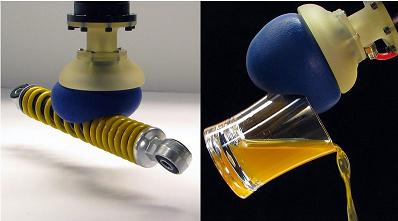
One of the world’s most versatile robot hands doesn’t look like a hand at all. iRobot’s universal robotic gripper is an elastic ball filled with grainy materials – like a bean bag chair in miniature. That little ball is really compliant, it will ooze around almost any shape with ease. Once it surrounds an object all you have to do is suck the air out of it and presto, the gripper gets stiff in a shape that perfectly matches the object it surrounds. Lift and move things around, and when you’re done just restore the air to the gripper and it will release its hold. This thing is really cool to watch in action. Check it out in the video below. Make sure to catch the part where it pours a drink (1:40) and draws a square (2:15) – that’s pretty impressive for a fingerless hand.
We first saw the universal gripper when Colin Angle, head of iRobot, demonstrated it at TEDMED as part of the many projects that could be used in the field of homecare and medicine. The basic concept of using suction to change a structure from pliable to stiff has been around for a while, but iRobot really highlighted its potential with the Blob Bot from this time last year. A robot arm that can pick up almost any small object without hurting it is a great concept, and I think the universal gripper shows that non-humanoid structures could play a major part in the future of human care robotics.
The universal gripper was recently discussed in an article in the Proceedings of the National Academy of Sciences, and iRobot revealed some of its limitations. Its success with objects depends a lot on their geometry. This thing couldn’t pick up a sheet of paper to save its life. It needs hard angles not flat surfaces. It also can’t handle very large objects, if there isn’t a surface less than half the size of the gripper ball you can pretty much forget about it. Maximum force was around 30 Newtons (~ 6.75 lbs), so don’t expect this ‘hand’ to help move people around. It even seems to struggle a little with the 0.65 kg shock absorber you see in the video.
What makes the gripper amazing – its ability to conform to any shape – also leads to some negatives. It needs a little resistance to form around something, and that means knocking things over if its not careful, so it won’t be good for gripping objects from the side. Also, the ‘jammable materials’ inside the gripper don’t work without a vacuum. Practically that means you have to actively pump on the ball to maintain a grip. The longer it holds something, the more power it will use. It doesn’t expend a ton of juice in the first place, but it’s a little disconcerting to have a hand that can’t hold something at rest. Maybe a vacuum holding valve would solve this?
I really don’t see the universal gripper replacing humanoid hands, but I do think they could augment them considerably. It wouldn’t be that hard to place this type of gripping ball on the wrist of a robot. That way when a fingered hand wasn’t delicate or versatile enough the robot could employ an alternative approach to picking the object up. For tiny objects like pills, the gripper would be better. For larger objects, like people, a more traditional model would work.
We’ll probably need a plurality of approaches to make robots work in a human environment. iRobot is smart to be looking at the medical industry. Healthcare costs are going to increase drastically as the global population continues to age, and robots are going to be needed to give elders the help so they can stay in their own homes and reduce the strain on hospitals and nursing facilities. I applaud iRobot’s cool approach to the robot hand, and I hope it inspires a wave of new innovation in robotic gripping. The universal gripper may not replace the humanoid hand, but if it gets us thinking more creatively, I’m all for it. …and it looks cool. I’m a sucker for things that look cool.
[image and video credits: Brown et al 2010 PNAS]
[sources: Brown et al 2010 PNAS]


